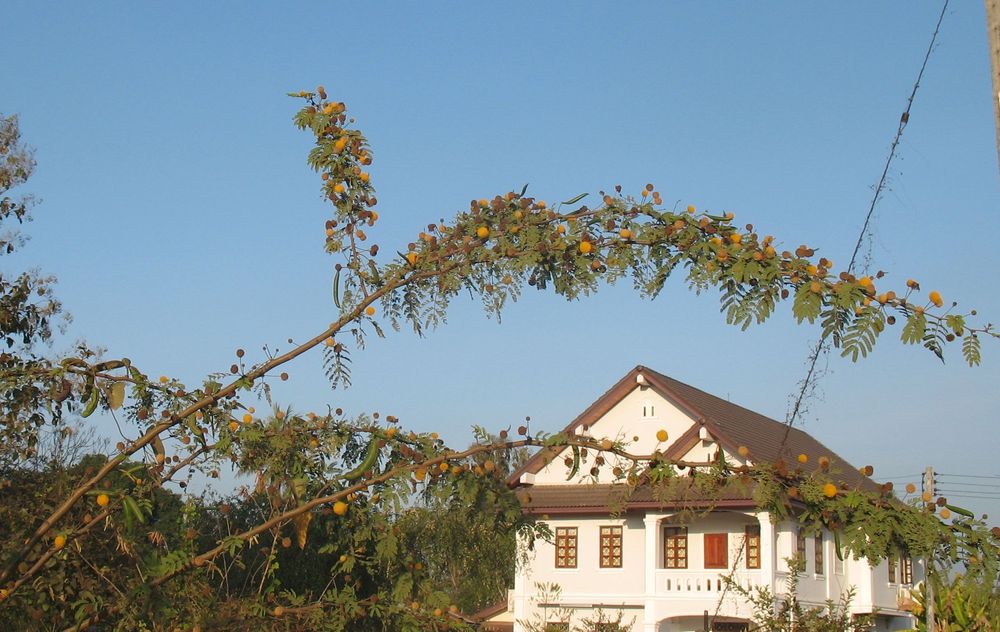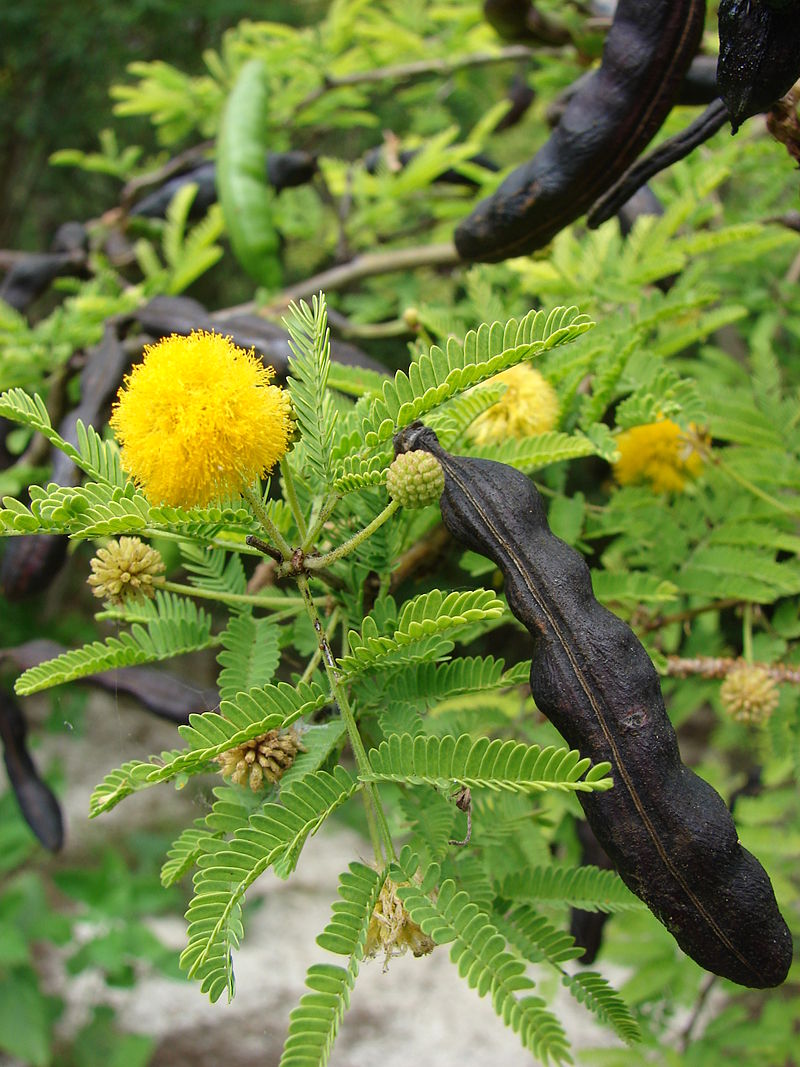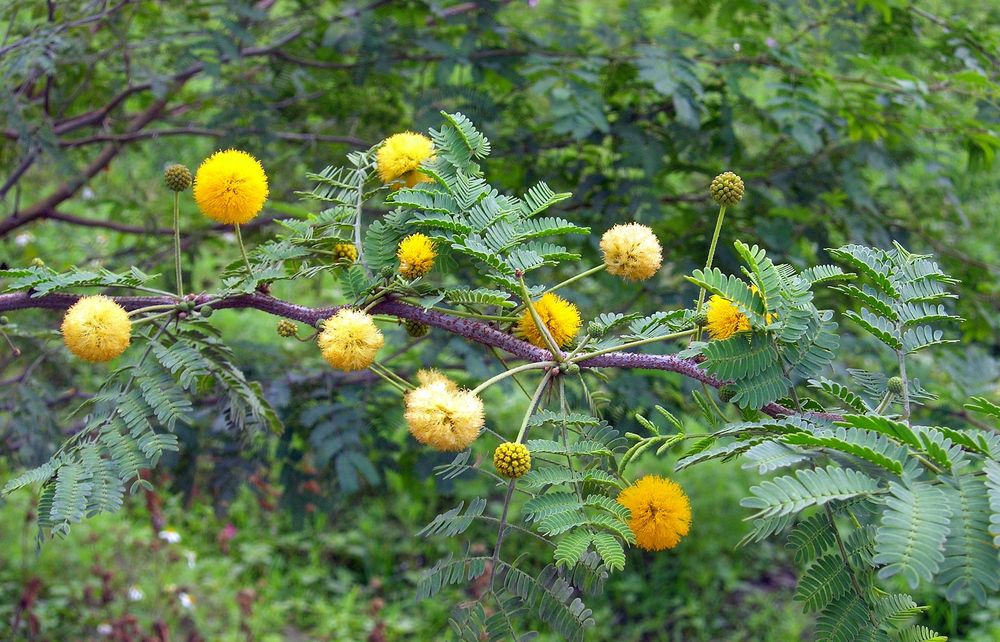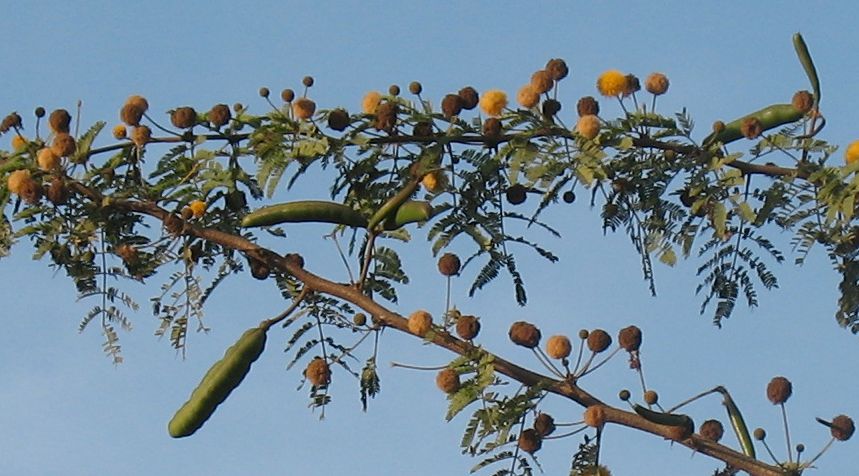You may have seen or rather smelled this plant at the bend of a path because its very characteristic scent evokes that of the mimosa of the South of France.
It is a small shrub with zigzag stems and compound leaves with a long white thorn at the base. The inflorescences are in capitula, that is to say in yellow pompoms. The pods are cylindrical, slightly curved and contain brown ovoid seeds.
This acacia native to America has become pantropical. In Lao it is named in reference to a very common food plant: kan thin, and it is added that it has thorns: kan thin nam. It is also called som poy ban because its foliage and its shape evokes som poy whose multiple uses are known in Laos.
Anderson tells us that the Lahu eat the young shoots of kan thin nam with fish. And Dr. Seng Aloun tells us that this cassia is used in traditional medicine to treat kidney diseases, leprosy, eczema. The plant is also said to be good for hair care, as is som poy.
Finally, let us point out that we saw in Laos a plantation of Acacia farnesiana intended to be exported for the perfume industry.
Vous avez peut-être vu ou plutôt senti cette plante au détour d’un chemin car son parfum, très caractéristique, évoque celui du mimosa du Midi de la France.
C’est un petit arbuste aux tiges en zigzag et aux feuilles composées avec à la base une longue épine blanche. Les inflorescences sont en capitules, c’est-à-dire en pompons jaunes. Les gousses sont cylindriques, légèrement courbées et contiennent des graines ovoïdes brunes.
Cet acacia originaire d’Amérique est devenu pantropical. En lao on le nomme en référence à une plante alimentaire très commune: kan thin, et on ajoute qu’elle a des épines: kan thin nam. On le nomme aussi som poy ban car son feuillage et son port évoque som poy dont on connaît les multiples usages au Laos.
Anderson nous dit que les Lahu mangent les jeunes pousses de kan thin nam avec du poisson. Et le docteur Seng Aloun nous apprend que cette cassie est employée en médecine traditionnelle pour soigner les maladies rénales, la lèpre, l’eczéma. La plante serait également bonne pour les soins des cheveux, comme d’ailleurs som poy.
Signalons enfin que nous avons vu au Laos une plantation d’Acacia farnesiana destinée à être exportée pour l’industrie de la parfumerie.




You may have seen or rather smelled this plant at the bend of a path because its very characteristic scent evokes that of the mimosa of the South of France.
It is a small shrub with zigzag stems and compound leaves with a long white thorn at the base. The inflorescences are in capitula, that is to say in yellow pompoms. The pods are cylindrical, slightly curved and contain brown ovoid seeds.
This acacia native to America has become pantropical. In Lao it is named in reference to a very common food plant: kan thin, and it is added that it has thorns: kan thin nam. It is also called som poy ban because its foliage and its shape evokes som poy whose multiple uses are known in Laos.
Anderson tells us that the Lahu eat the young shoots of kan thin nam with fish. And Dr. Seng Aloun tells us that this cassia is used in traditional medicine to treat kidney diseases, leprosy, eczema. The plant is also said to be good for hair care, as is som poy.
Finally, let us point out that we saw in Laos a plantation of Acacia farnesiana intended to be exported for the perfume industry.
Vous avez peut-être vu ou plutôt senti cette plante au détour d’un chemin car son parfum, très caractéristique, évoque celui du mimosa du Midi de la France.
C’est un petit arbuste aux tiges en zigzag et aux feuilles composées avec à la base une longue épine blanche. Les inflorescences sont en capitules, c’est-à-dire en pompons jaunes. Les gousses sont cylindriques, légèrement courbées et contiennent des graines ovoïdes brunes.
Cet acacia originaire d’Amérique est devenu pantropical. En lao on le nomme en référence à une plante alimentaire très commune: kan thin, et on ajoute qu’elle a des épines: kan thin nam. On le nomme aussi som poy ban car son feuillage et son port évoque som poy dont on connaît les multiples usages au Laos.
Anderson nous dit que les Lahu mangent les jeunes pousses de kan thin nam avec du poisson. Et le docteur Seng Aloun nous apprend que cette cassie est employée en médecine traditionnelle pour soigner les maladies rénales, la lèpre, l’eczéma. La plante serait également bonne pour les soins des cheveux, comme d’ailleurs som poy.
Signalons enfin que nous avons vu au Laos une plantation d’Acacia farnesiana destinée à être exportée pour l’industrie de la parfumerie.








You may have seen or rather smelled this plant at the bend of a path because its very characteristic scent evokes that of the mimosa of the South of France.
It is a small shrub with zigzag stems and compound leaves with a long white thorn at the base. The inflorescences are in capitula, that is to say in yellow pompoms. The pods are cylindrical, slightly curved and contain brown ovoid seeds.
This acacia native to America has become pantropical. In Lao it is named in reference to a very common food plant: kan thin, and it is added that it has thorns: kan thin nam. It is also called som poy ban because its foliage and its shape evokes som poy whose multiple uses are known in Laos.
Anderson tells us that the Lahu eat the young shoots of kan thin nam with fish. And Dr. Seng Aloun tells us that this cassia is used in traditional medicine to treat kidney diseases, leprosy, eczema. The plant is also said to be good for hair care, as is som poy.
Finally, let us point out that we saw in Laos a plantation of Acacia farnesiana intended to be exported for the perfume industry.
Vous avez peut-être vu ou plutôt senti cette plante au détour d’un chemin car son parfum, très caractéristique, évoque celui du mimosa du Midi de la France.
C’est un petit arbuste aux tiges en zigzag et aux feuilles composées avec à la base une longue épine blanche. Les inflorescences sont en capitules, c’est-à-dire en pompons jaunes. Les gousses sont cylindriques, légèrement courbées et contiennent des graines ovoïdes brunes.
Cet acacia originaire d’Amérique est devenu pantropical. En lao on le nomme en référence à une plante alimentaire très commune: kan thin, et on ajoute qu’elle a des épines: kan thin nam. On le nomme aussi som poy ban car son feuillage et son port évoque som poy dont on connaît les multiples usages au Laos.
Anderson nous dit que les Lahu mangent les jeunes pousses de kan thin nam avec du poisson. Et le docteur Seng Aloun nous apprend que cette cassie est employée en médecine traditionnelle pour soigner les maladies rénales, la lèpre, l’eczéma. La plante serait également bonne pour les soins des cheveux, comme d’ailleurs som poy.
Signalons enfin que nous avons vu au Laos une plantation d’Acacia farnesiana destinée à être exportée pour l’industrie de la parfumerie.


